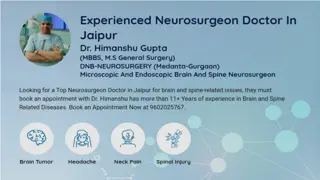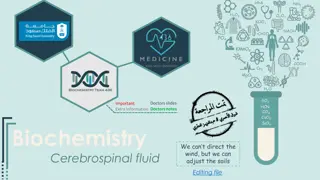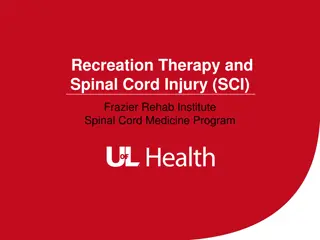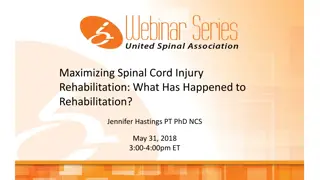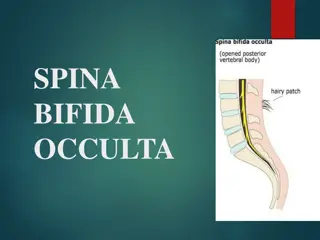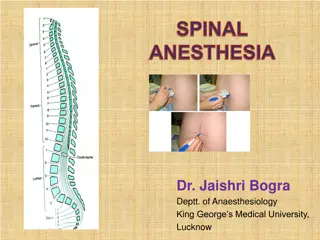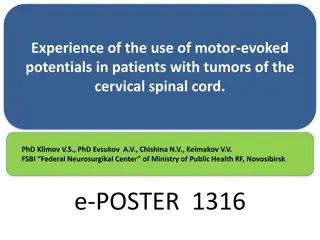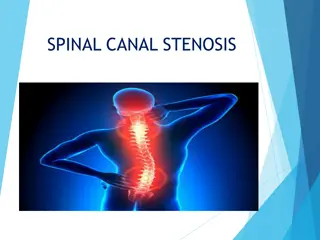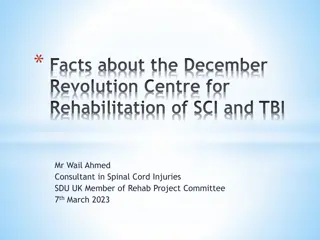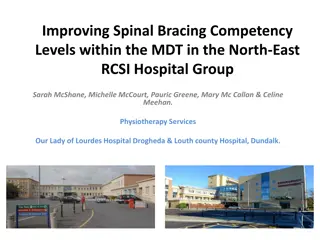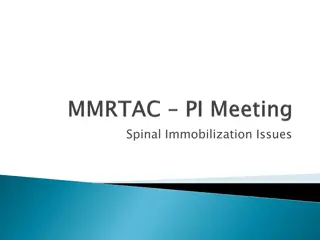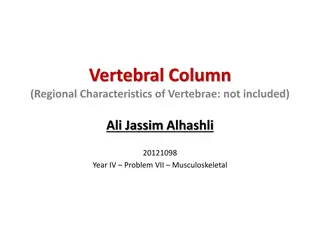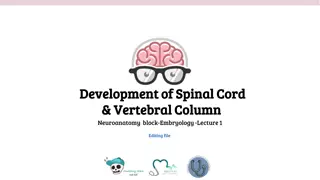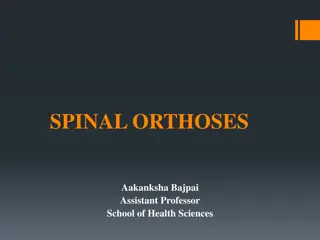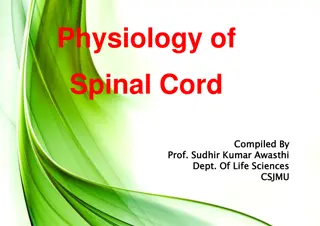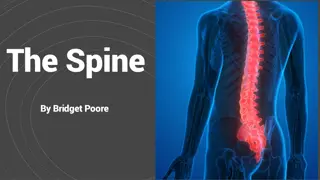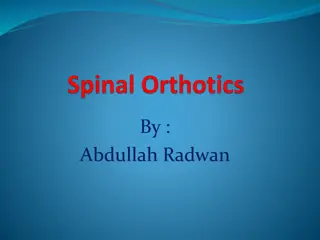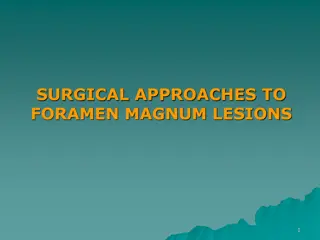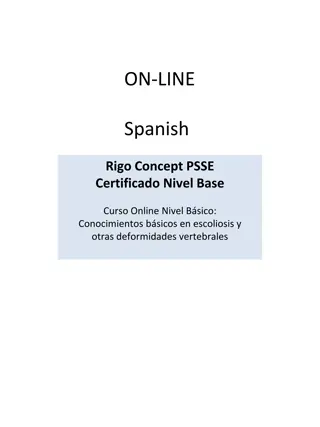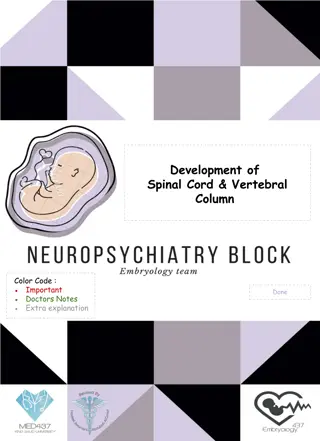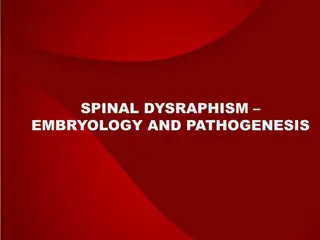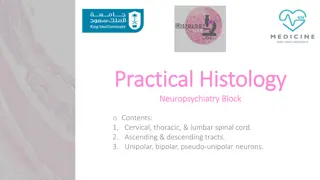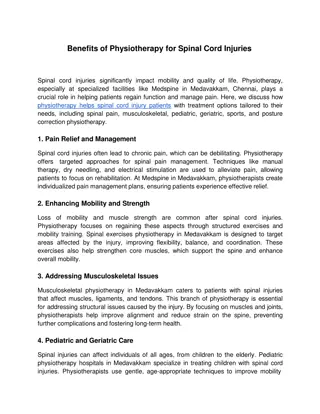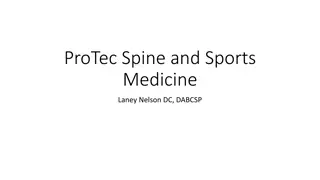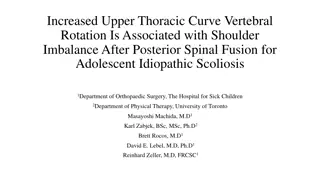Spinal injuries
An overview of spinal injuries, including anatomy revision, types of spinal fractures, assessment, management, and common patterns of injuries. It also covers back pain presentation, red flags, differentials, and the structure of vertebrae. The Denis classification of spinal fractures and the most c
3 views • 40 slides
Cord Cutting 2.0 Versus 5G Home Internet
The battle between 5G and cord-cutting 2.0 is reshaping the entertainment landscape. Dive into the seismic shift in how we consume content and the disruptors fueling this transformation.
3 views • 6 slides
Best Neurosurgeons in India
A neurosurgeon is a specialized trained doctor who diagnoses and treats patients who suffer from nervous system problems including the brain, and spinal cord. Neurosurgeons complete their specialist training in neurosurgery which may take between 5 to 9 years. Neurosurgeons perform surgery on the ne
1 views • 3 slides
_Best Neurosurgeon Doctor In Jaipur || Dr Himanshu Gupta || drhimanshugupta.com
Dr. Himanshu Gupta is known not only for his mastery of surgical techniques, particularly in microsurgery and Endosurgery for brain tumors but also for his exceptional skills in managing patients requiring trauma, brain, and spine surgeries.\n\nHis focus lies in exclusive neurosurgery, making him a
0 views • 7 slides
Cerebrospinal Fluid (CSF): Functions, Formation, and Circulation
Cerebrospinal fluid (CSF) plays a vital role in providing a controlled chemical environment, nutrient supply, waste removal, and physical support and protection to the brain and spinal cord. This fluid circulates around the central nervous system, and its formation involves processes like selective
0 views • 23 slides
Comprehensive Recreation Therapy for Spinal Cord Injury Patients
Recreation therapy for individuals with spinal cord injuries at Frazier Rehab Institute focuses on developing life skills, community reintegration, education and support in various areas, leisure education, awareness, and community re-integration. The program provides opportunities for individuals t
0 views • 13 slides
Maximizing Spinal Cord Injury Rehabilitation: Insights and Advocacy Efforts
Explore the journey of spinal cord injury rehabilitation, challenges faced, and advocacy efforts by organizations like United Spinal Association. The impact of sudden onset spinal cord injuries on various aspects of life is highlighted, along with the importance of support and legislative advocacy.
1 views • 27 slides
Spina Bifida Occulta: Symptoms, Causes, and Treatment
Spina Bifida Occulta is a common neural tube defect, usually mild and hidden. It affects the lumbosacral area, characterized by vertebral arches not fusing, resulting in spinal processes defects without external protrusion. Common features include dimples, hairy patches, and normal spinal cord. Neur
0 views • 10 slides
An Overview of Spinal Anesthesia in Regional Anesthesia Practice
Regional anesthesia, specifically spinal anesthesia, is a valuable technique involving the application of local anesthetic around a nerve to reduce or prevent impulse transmission. This method offers numerous advantages, such as cost-effectiveness, respiratory support, and post-operative pain relief
0 views • 46 slides
Use of Motor-Evoked Potentials in Cervical Spinal Cord Tumor Patients
Neurophysiological intraoperative monitoring using motor-evoked potentials is crucial in evaluating spinal cord function during surgery for cervical spinal cord tumors. This study examines the relationship between neurological changes and intraoperative motor-evoked potentials in patients, aiming to
0 views • 8 slides
Spinal Canal Stenosis: Causes, Symptoms, and Classification
Spinal canal stenosis is the abnormal narrowing of the spinal canal or intervertebral foramina, leading to compression of nerves and blood vessels. It can result in symptoms such as radiculopathy, claudication, myelopathy, and more. Cervical stenosis presents with arm pain and weakness, while lumbar
0 views • 18 slides
Development of a Tertiary Neurological Rehabilitation Centre in Sudan
The December Revolution Centre for Rehabilitation of Traumatic Spinal Cord and Brain Injuries at Khartoum Teaching Hospital addresses the lack of holistic patient-centered rehabilitation services in Sudan. Following the December 2018 Revolution, the need for specialized care for victims with spinal
0 views • 11 slides
Designing a Safe Bungee Cord for Washy Meet Washy!
Engineering students embark on a challenge to create a safe bungee cord for Washy at Crazy Town. Through story time, defining forces, brainstorming, and discussing cord lengths, they learn about displacement, force calculation, and using Hooke's law for spring constant. The activity aims to measure
0 views • 27 slides
Transforming Spinal Pathology Care: Belgian Registry Startup Journey
Experience the journey of establishing a national registry for spinal pathologies in Belgium, led by Johan G. Van Lerbeirghe. Explore the goals, history, and the significance of choosing Spine Tango as the registry platform. Witness the challenges, partnerships, and milestones in the Belgian Pilot p
0 views • 14 slides
Enhancing Spinal Bracing Competency in Healthcare Settings
This quality improvement project aimed to elevate spinal bracing competency among healthcare staff in the North-East RCSI Hospital Group. By focusing on training and upskilling physiotherapy, nursing, and healthcare assistant staff, the project successfully increased knowledge and understanding of s
0 views • 4 slides
Spinal Immobilization in Trauma: Case Study and Considerations
A 70-year-old male with trauma after falling 20 feet was managed at the ED, demonstrating tenderness in the mid thoracic spine and other injuries. Despite negative cervical spine imaging, the patient underwent interventions for spinal fractures. The decision to transfer without a backboard highlight
0 views • 34 slides
Vertebral Column and Abnormal Curvatures
The vertebral column, extending from the cranium to the coccyx, plays vital roles in protecting the spinal cord, providing support, and facilitating movement. It consists of 33 vertebrae arranged in 5 regions, each with specific functions and characteristics. The column's curvatures, including cervi
0 views • 12 slides
Embryology of Spinal Cord and Vertebral Column Development
Explore the fascinating embryological journey of the spinal cord and vertebral column development, covering topics such as neural tube formation, layers of the spinal cord, subdivisions of mantle and marginal zones, chondrification, ossification stages, spina bifida types, and more. Dive into the st
1 views • 15 slides
Spinal Orthoses: Types, Uses, and Benefits
Spinal orthoses are back braces used to treat spinal disorders and injuries. They provide support, limit movement, and aid in healing. Orthoses are prescribed to realign the spine, immobilize it, limit mobility, and support weakened areas. Various types of orthoses are available based on the segment
0 views • 38 slides
The Physiology of the Spinal Cord
The spinal cord serves as the information highway between the brain and body, allowing for sensory input reception and motor signal transmission. It plays a crucial role in locomotion, reflex responses, and overall coordination of muscle activities. The cylinder of nerve tissue within the vertebral
0 views • 18 slides
Joint Disabilities and Ankylosis in Spinal Health
Factors contributing to joint disabilities in spinal health include limited or excessive movement, muscle weakness, and fatigue. Painful motion, muscle spasm, and joint alignment issues can indicate disability. Ankylosis, seen in conditions like ankylosing spondylitis, results in joint fusion and im
0 views • 19 slides
Orthoses: Types, Indications, Mechanisms, and Effects
Orthoses are mechanical devices used to support, stabilize, and protect various body parts. They can be categorized into different types such as cervical, cervicothoracic, thoracolumbosacral, lumbosacral, and sacroiliac orthoses. Indications for spinal orthotics include stabilizing the spine after a
0 views • 34 slides
Surgical Approaches to Foramen Magnum Lesions: Anatomy and Considerations
Surgical approaches to foramen magnum lesions involve understanding the anatomical structures, diameters, condyles, and contents of the region. Critical considerations include the choice of surgical approach based on the location and extent of the lesion, size, and nature of the pathology. Approache
0 views • 53 slides
Certification in Rigo Concept PSSE for Scoliosis and Spinal Deformities
This online course offers a base level certification in Rigo Concept PSSE, focusing on essential knowledge of scoliosis and other spinal deformities. Led by renowned professionals in the field, successful completion of the course allows access to further levels of certification for specific physical
0 views • 12 slides
Development of Spinal Cord and Vertebral Column - Doctors' Notes
The development of the spinal cord from the neural tube, layers of the spinal cord, subdivisions of mantle and marginal zones, meningeal layers, vertebral column development, chondrification, ossification stages, spina bifida types, and positional changes of the spinal cord are crucial aspects cover
0 views • 10 slides
Embryology and Pathogenesis of Spinal Dysraphism
Gastrulation, the formation of germ layers, mesoderm, and endoderm, in the embryo occurs during the third week of gestation with the appearance of the primitive streak. Cells migrate to form endoderm and mesoderm while the ectoderm remains. Neural induction is regulated by factors like fibroblast gr
0 views • 49 slides
Practical Histology: Spinal Cord Tracts and Neurons Overview
This practical histology guide covers the cervical, thoracic, and lumbar spinal cord segments, along with ascending and descending tracts, and pseudo-unipolar/unipolar neurons. It emphasizes key features such as the ventral and dorsal horns, gracile and cuneate tracts, and provides essential informa
1 views • 12 slides
Validation of Plasmalyte in Cordwashing - Cord blood processing and quality control
This detailed documentation covers the validation process of using Plasmalyte in cord blood washing procedures, providing insights into the reasons for washing cord blood units, current standards, acceptance criteria, and the use of validated methods like Sepax cord wash. It emphasizes the importanc
0 views • 16 slides
Benefits of Physiotherapy for Spinal Cord Injuries
Physiotherapy is an extreely important part of treatment for spinal problems. Multiple physiotherapy modalities are useful in relieving spinal pain. Personalisedexercise programs are tailored to each patient\u2019s Specific Problems.
0 views • 2 slides
Role of Multifidus Muscle in Spinal Health
Exploring the multifaceted role of the multifidus muscle in lumbar spine stability and control through histochemical studies and clinical comparisons. Insights into muscle changes with spinal conditions and the importance of maintaining its integrity for overall spinal health are discussed.
0 views • 26 slides
United Spinal Association: Empowering People with Disabilities
The United Spinal Association is dedicated to enhancing the quality of life for wheelchair users and the broader disability community. With over 75 years of commitment, they empower individuals with spinal cord injuries and disorders to achieve the highest possible quality of life through advocacy,
0 views • 7 slides
United Spinal Association: Empowering Individuals with Disabilities
United Spinal Association is dedicated to enhancing the quality of life for wheelchair users and individuals with spinal cord injuries and disorders. With over 75 years of experience, they provide support, advocacy, and resources to empower people with disabilities to achieve their fullest potential
0 views • 7 slides
Chiropractic Science and Research Overview
This compilation presents research findings on chiropractic science, focusing on topics such as upper cervical physiology, pathophysiology related to vertebral lesions, and congenital anomalies in the spine. Highlighted studies explore the impact of mechanical stresses on the spinal cord, neurologic
0 views • 47 slides
Effectiveness of Gentian Violet Cord Care in Preventing Umbilical Cord Sepsis
This study compares the effectiveness of Gentian Violet cord care versus standard air-dry cord care in preventing umbilical cord sepsis among newborns at Port Moresby General Hospital, Papua New Guinea. The aim is to reduce neonatal mortality associated with neonatal cord sepsis.
2 views • 19 slides
Upper Thoracic Curve Rotation and Shoulder Imbalance Post-Spinal Fusion
This study explores the association between increased upper thoracic curve vertebral rotation and shoulder imbalance following posterior spinal fusion for adolescent idiopathic scoliosis. Radiographic measurements, demographics, and follow-up outcomes are analyzed to quantify the effect of surgery o
0 views • 10 slides
Spinal Cord Complications and Management
Acute autonomic dysreflexia, postural hypotension, heterotopic ossification, hypercalcemia, DVT/PE, chronic osteoporosis, Charcot spine, renal complications, and more are common complications of spinal cord injuries. Understanding the symptoms and treatments for these complications is vital in manag
0 views • 14 slides
The Spinal Cord Injury Model System (SCIMS)
This content discusses the genesis of the Spinal Cord Injury Model System (SCIMS) and its role in providing comprehensive care for individuals with spinal cord injuries. Established in 1970, the SCIMS program focuses on treating direct injuries, functional deficits, psychological adjustments, and lo
0 views • 79 slides
Surgical Approaches to Foramen Magnum Lesions
Surgical approaches to treat lesions at the foramen magnum involve careful consideration of the anatomical structures and the choice of either posterior, anterior, or lateral approach based on the location and nature of the lesion. Key structures involved include the brain stem, spinal cord, lower c
0 views • 52 slides
Motion-Sparing Spinal Disc Replacement Study
This case study discusses a new motion-sparing spinal disc replacement developed by Kenneth R. St. John, PhD. It includes components, concepts, and recommendations from a workshop on medical device regulation. The study explores materials used, potential concerns, and safety considerations associate
0 views • 27 slides
Understanding Spinal Cord Injury - Dr. Shivam Gour
Dr. Shivam Gour, a renowned brain and spine surgeon from kolkata, he is acclaimed for his outstanding skills in management of complicated and critical brain and spinal cord ailments. Dr. Shivam Gour has a rich overall experience of over 9 years in su
3 views • 4 slides



